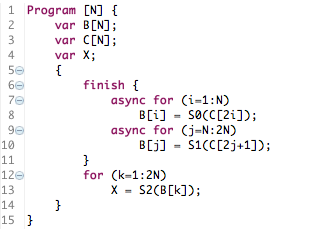Polyhedral X10 Dataflow Analyzer is a prototype implementation of an extension to Array Data-flow analysis for a subset of X10 programs. Our proposed technique will appear in PPoPP 2013. We restrict the programs to be affine control, and support a subset of parallel constructs; "async" and "finish". For this class of X10 programs, our analysis provides instance-wise and element-wise dependence information.
We apply the dependence information for detecting data races in X10 programs. The data-flow analysis answers the question: which instance of which statement produced the value read by an instance of a statement. For parallel programs with data races, a single read has multiple writers. This is the basic idea behind applying data-flow analysis to data-race detection.
We use a simplified mini-X10 language that strips out unnecessary information for our analysis. For example, since the operations performed in a statement are not relevant to dependence analysis, and so the right hand side expressions in all assignement statements are simply labeled functions. The mini-language looks like the following.

Note how the RHS of assignment statements are just functions that take as
parameters, the values of instances of array variables in the program. Since
the details of the operations are not relevant, all statements are expressed
as such functions (the function names mut all be unique). In the above
example, instances of statement S0 and S1 execute in
parallel. These two statements do not conflict for most iterations,
but B[N] is written by both the statements, causing
data-race.
In response to a series of "Questions," asking for the source(s) of a specific read reference, our analysis produces the following output:
Question (S0, C[2*i]):
input dependence
Question (S1, C[2*j + 1]):
input dependence
Question (S2, B[k]):
S0[k]
IF {k|k-1>=0 && -k+2N>=0 && -k+N>=0}
S1[k]
IF {k|k-1>=0 && -k+2N>=0 && k-N>=0}
and additionally, reports any data-races detected as ambiguous sources:
[Ambiguous Source] S2(B[k]) has two sources S0[k] and S1[k] at [N] -> {[k] : (k + -1*N = 0) and (-1 + N >= 0)}
The output lists the data-flow analysis questions, and the corresponding
answer in the form of a Quast (quasi-affine solution tree, that can be viewed
as a piecewise affine function). In the above, Question (S2,
B[k]) asks which instance of which statement produced values read by
reference B[k] in statement S2. The answer to the
question is a quast with two branches:
S0[k] (k-th iteration of statement S0) when 1≤ k ≤ NS1[k] (k-th iteration of statement S1) when N≤ k ≤ 2Nk=N is reported separately.
Please refer to the documentation in our distribution for further information regarding the syntax of input language and outputs.
Our system uses a number of tools developed for Eclipse, such as the Xtext parser generator, and requires some of the libraries from Eclipse. In addition, we have an editor integrated with Eclipse that provides syntax highlighting and context assists (which come for free when using Xtext).
We provide an Eclipse bundle for a version of our tool integrated into Eclipse.
Import... -> General -> Existing Projects into Workspace, and then select from archive)
$java -jar polyX10.jar x10src/examplePaper2.x10p
Program [N] {
var B[N]
var C[N]
var X
{
finish {
async for (i=1:N)
B[i] = S0(C[2i]);
async for (j=N:2N)
B[j] = S1(C[2j+1]);
}
for (k=1:2N)
X = S2(B[k]);
}
}
/*
[Ambiguous Source] S2(B[k]) has two sources S0[k] and S1[k] at [N] -& {[k] : (k + -1*N = 0) and (-1 + N &= 0)}
Question (S2, B[k]):
S0[k]
IF {k|k-1&=0 && -k+2N&=0 && -k+N&=0}
S1[k]
IF {k|k-1&=0 && -k+2N&=0 && k-N&=0}
*/